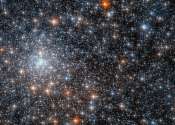Globular cluster NGC 6558 explored with Gemini Observatory and Hubble Space Telescope
Using the Gemini Observatory and the Hubble Space Telescope (HST), an international team of astronomers has investigated a Galactic globular cluster known as NGC 6558. Results of the new study, published July 22 on the pre-print ...









